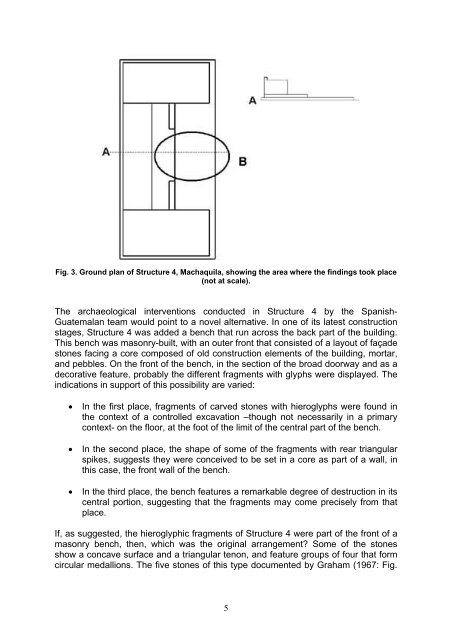63 an epigraphic account related to structure 4 at ... - Famsi
63 an epigraphic account related to structure 4 at ... - Famsi
63 an epigraphic account related to structure 4 at ... - Famsi
You also want an ePaper? Increase the reach of your titles
YUMPU automatically turns print PDFs into web optimized ePapers that Google loves.
Fig. 3. Ground pl<strong>an</strong> of Structure 4, Machaquila, showing the area where the findings <strong>to</strong>ok place<br />
(not <strong>at</strong> scale).<br />
The archaeological interventions conducted in Structure 4 by the Sp<strong>an</strong>ish-<br />
Gu<strong>at</strong>emal<strong>an</strong> team would point <strong>to</strong> a novel altern<strong>at</strong>ive. In one of its l<strong>at</strong>est construction<br />
stages, Structure 4 was added a bench th<strong>at</strong> run across the back part of the building.<br />
This bench was masonry-built, with <strong>an</strong> outer front th<strong>at</strong> consisted of a layout of façade<br />
s<strong>to</strong>nes facing a core composed of old construction elements of the building, mortar,<br />
<strong>an</strong>d pebbles. On the front of the bench, in the section of the broad doorway <strong>an</strong>d as a<br />
decor<strong>at</strong>ive fe<strong>at</strong>ure, probably the different fragments with glyphs were displayed. The<br />
indic<strong>at</strong>ions in support of this possibility are varied:<br />
• In the first place, fragments of carved s<strong>to</strong>nes with hieroglyphs were found in<br />
the context of a controlled excav<strong>at</strong>ion –though not necessarily in a primary<br />
context- on the floor, <strong>at</strong> the foot of the limit of the central part of the bench.<br />
• In the second place, the shape of some of the fragments with rear tri<strong>an</strong>gular<br />
spikes, suggests they were conceived <strong>to</strong> be set in a core as part of a wall, in<br />
this case, the front wall of the bench.<br />
• In the third place, the bench fe<strong>at</strong>ures a remarkable degree of destruction in its<br />
central portion, suggesting th<strong>at</strong> the fragments may come precisely from th<strong>at</strong><br />
place.<br />
If, as suggested, the hieroglyphic fragments of Structure 4 were part of the front of a<br />
masonry bench, then, which was the original arr<strong>an</strong>gement? Some of the s<strong>to</strong>nes<br />
show a concave surface <strong>an</strong>d a tri<strong>an</strong>gular tenon, <strong>an</strong>d fe<strong>at</strong>ure groups of four th<strong>at</strong> form<br />
circular medallions. The five s<strong>to</strong>nes of this type documented by Graham (1967: Fig.<br />
5
















